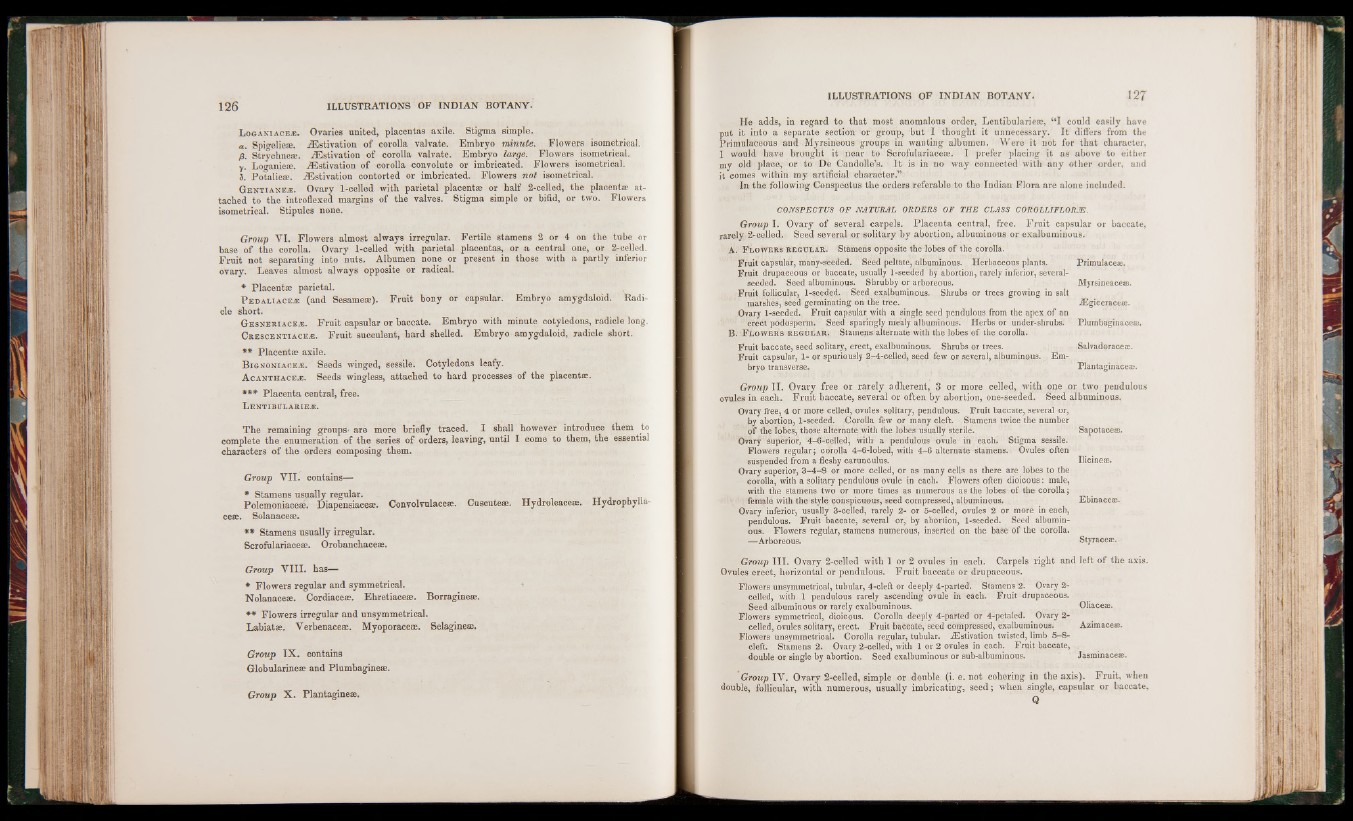
126 ILLUSTRATIONS OF INDIAN BOTANY.
Loganiaceæ. Ovaries united, placentas axile. Stigma simple.
a. Spigelieæ. Æstivation of corolla valvate. Embryo minute. Flowers isometrical.
ß. Strychneæ. Æstivation of corolla valvate. Embryo large. Flowers isometrical.
y. Loganieæ. Æstivation of corolla convolute or imbricated. Flowers isometrical.
3. Potalieæ. Æstivation contorted or imbricated. Flowers not isometrical.
Gentianeæ. Ovary 1-celled with parietal placentæ or half 2-celled, the placentae attached
to the introflexed margins of the valves. Stigma simple or bifid, or two. Flowers
isometrical. Stipules none.
Group VI. Flowers almost always irregular. Fertile stamens 2 or 4 on the tube or
base of the corolla. Ovary 1-celled with parietal placentas, or a central one, or 2-celled.
Fruit not separating into nuts. Albumen none or present in those with a partly inferior
ovary. Leaves almost always opposite or radical.
* Placentas parietal.
P edaliace,e (and Sesameas). Fruit bony or capsular. Embryo amygdaloid. Radicle
short.
Gesneriacejs. Fruit capsular or baccate. Embryo with minute cotyledons, radicle long.
Crescentiace*:. Fruit succulent, hard shelled. Embryo amygdaloid, radicle short.
** Placentae axile.
Bignoniace.«. Seeds winged, sessile. Cotyledons leafy.
A canthacejs. Seeds wingless, attached to hard processes of the placentae.
*** Placenta central, free.
Lentibularie.®.
The remaining groups« are more briefly traced. I shall however introduce them to
complete the enumeration of the series of orders, leaving, until I come to them, the essential
characters of the orders composing them.
Group VII. contains—
* Stamens usually regular.
Polemoniaceae. Diapensiaceae. Convolvulaceae. Cuscuteae. Hydroleaceae. Hydropbylla-
ceae. Solanaceae.
** Stamens usually irregular.
Scrofulariaceae. Orobanchaceae.
Group V III. has—
* Flowers regular and symmetrical.
Nolanaceae. Cordiaceae. Ehretiaceae. Borragineae.
** Flowers irregular and unsymmetrical.
Labiatae. Verbenaceae. Myoporaceae. Selagineae.
Group IX. contains
Globularineae and Plumbagineae.
Group X. Plantagineæ.
He adds, in regard to that most anomalous order, Lentibularieae, “I could easily have
put it into a separate section or group, but I thought it unnecessary. It differs from the
Primulaceous and Myrsineous groups in wanting albumen. Were it not for that character,
I would have brought it near to Scrofulariaceae. I prefer placing it as above to either
my old place, or to De Candolle’s. I t is in no way connected with any other order, and
it comes within my artificial character.”
In the following Conspectus the orders referable to the Indian Flora are alone included.
CONSPECTUS OF NATURAL ORDERS OF THE CLASS COROLLIFLORÆ.
Group I. Ovary of several carpels. Placenta central, free. Fruit capsular or baccate,
rarely 2-celled. Seed several or solitary by abortion, albuminous or exalbuminous.
A. Flowers regular. Stamens opposite the lobes of the corolla.
Fruit capsular, many-seeded. Seed peltate, albuminous. Herbaceous plants.
Fruit drupaceous or baccate, usually 1-seeded by abortion, rarely inferior, several-
seeded. Seed albuminous. Shrubby or arboreous.
Fruit follicular, 1-seeded. Seed exalbuminous. Shrubs or trees growing in salt
marshes, seed germinating on the tree.
Ovary 1-seeded. Fruit capsular with a single seed pendulous from the apex of an
erect podosperm. Seed sparingly mealy albuminous. Herbs or under-shrubs.
B. Flowers regular. Stamens alternate with the lobes of the corolla.
Primulacese.
Myrsineaceæ.
Ægiceraceæ.
Plumbaginaceæ.
Fruit baccate, seed solitary, erect, exalbuminous. Shrubs or trees. Salvadoraceae.
Fruit capsular, 1- or spuriously 2-4-eelled, seed few or several, albuminous. Embryo
transverse. Plantaginaceae.
Group II. Ovary free or rarely adherent, 3 or more celled, with one or two pendulous
ovules in each. Fruit baccate, several or often by abortion, one-seeded. Seed albuminous.
Ovary free, 4 or more celled, ovules solitary, pendulous. Fruit baccate, several or,
by abortion, 1-seeded. Corolla few or many cleft. Stamens twice the number
of the lobes, those alternate with the lobes usually sterile.
Ovary superior, 4-6-ceIled, with a pendulous ovule in each. Stigma sessile.
Flowers regular; corolla 4-6-lobed, with 4-6 alternate stamens. Ovules often
suspended from a fleshy carunculus.
Ovary superior, 3-4-8 or more celled, or as many cells as there are lobes to the
corolla, with a solitary pendulous ovule in each. Flowers often dioicous: male,
with the stamens two or more times as numerous as the lobes of the corolla;
female with the style conspicuous, seed compressed, albuminous.
Ovary inferior, usually 3-celled, rarely 2- or 5-celled, ovules 2 or more in each,
pendulous. Fruit baccate, several or, by abortion, 1-seeded. Seed albuminous.
Flowers regular, stamens numerous, inserted on the base of the corolla.
—Arboreous.
Sapotaceæ.
Ilicineæ.
Ebinaceæ.
Styraceæ.
Group III. Ovary 2-celled with 1 or 2 ovules in each. Carpels right and left of the axis.
Ovules erect, horizontal or pendulous. Fruit baccate or drupaceous.
Flowers unsymmetrical, tubular, 4-cleft or deeply 4-parted. Stamens 2. Ovary 2-
celled, with 1 pendulous rarely ascending ovule in each. Fruit drupaceous.
Seed albuminous or rarely exalbuminous. Oliaceae.
Flowers symmetrical, dioicous. Corolla deeply 4-parted or 4-petaled. Ovary 2-
celled, ovules solitary, erect. Fruit baccate, seed compressed, exalbuminous. Azimaces.
Flowers unsymmetrical. Corolla regular, tubular. ^Estivation twisted, limb 5-8-
cleft. Stamens 2. Ovary 2-celled, with 1 or 2 ovules in each. Fruit baccate, .
double or single by abortion. Seed exalbuminous or sub-albuminous. Jasminaceas.
Group IV. Ovary 2-celled, simple or double (i. e. not cohering in the axis). Fruit, when
double, follicular, with numerous, usually imbricating, seed; when single, capsular or baccate,
Q